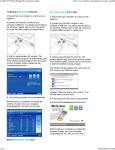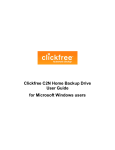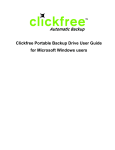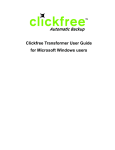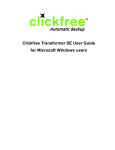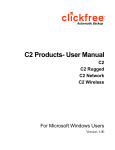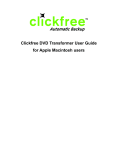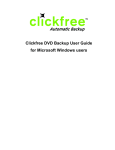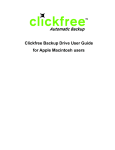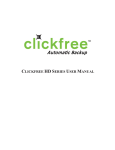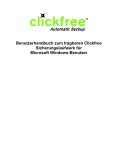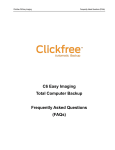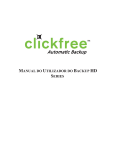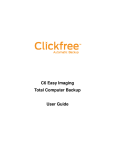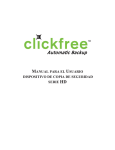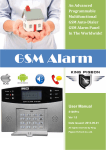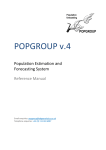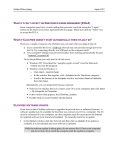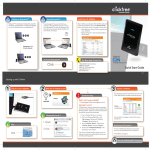Download Clickfree™ C2 USER GUIDE
Transcript
Clickfree™ C2 Portable/Desktop Backup Drives Covers USB 2.0 and 3.0 Versions USER GUIDE for Microsoft Windows users Version 2.00 Copyright © 2011 Storage Appliance Corporation. All rights reserved. The information contained in this guide is provided by Storage Appliance Corporation and while we try to keep the information up-to-date and correct, we make no representations or warranties of any kind, express or implied, about the completeness, accuracy, reliability, or suitability of the information or related products. Any reliance you place on such information is therefore strictly at your own risk. In no event will we be liable for any loss or damage including without limitation, indirect or consequential loss or damage, or any loss or damage whatsoever arising from loss of data or profits arising out of, or in connection with, the use of this information or related products. The specifications and performance of the products manufactured by Storage Appliance Corporation and featured in this publication may be changed without notice. Clickfree and the Clickfree logo are trademarks or registered trademarks of Storage Appliance Corporation. Other product names used in this guide are recognized as trademarks or registered trademarks of their owners. USER MANUAL -‐ Clickfree C2 Portable/Desktop Backup Drives – USB2.0/3.0 Page 2 Contents 1.0 USING THE CLICKFREE C2 BACKUP DRIVE 1.1 1.2 5 Package contents 5 1.1.1 1.1.2 1.1.3 1.1.4 5 5 5 5 Clickfree C2 Portable backup drive (USB 2.0 ) Clickfree C2 Desktop backup drive (USB 2.0 ) Clickfree C2 Portable backup drive (USB 3.0 ) Clickfree C2 Desktop backup drive (USB 3.0 ) Definitions 5 2.0 INTRODUCING CLICKFREE C2 BACKUP DRIVE 2.1 How Clickfree backs up 2.2 Main Features 7 7 7 3.0 BASICS 9 3.1 3.2 3.3 3.4 3.5 How does Clickfree work? What gets backed up? Does Clickfree back up all of my content every time? What content categories does Clickfree back up? What do I need before I start? 9 9 10 10 10 4.0 BACKING UP MY CONTENT 4.1 How do I start using my Clickfree C2 Backup Drive? 4.2 Zero effort backup – really! 11 11 12 4.3 4.4 4.4 4.2.1 Backup progress 13 What if Clickfree doesn’t start up automatically? How do I Change how Clickfree does backups? 14 15 4.4.1 Choosing categories of content to be backed up – required 4.4.2 Choosing locations to search for content – required 4.4.3 Choosing complete folders to be backed up – optional 17 18 20 What if there is not enough space on my Clickfree C2 Backup Drive? 23 5.0 RESTORING MY CONTENT 25 5.1 What if my computer’s internal hard drive stops working, or I would like to transfer my content to a new computer? 25 5.2 What do I need before I can use Clickfree to restore my content? 25 5.3 How do I get my content back? 25 5.4 5.5 5.3.1 What gets restored, and to where? 26 How do I let Clickfree restore decide what to restore and where? How do I change how Clickfree restores content? 26 29 5.5.1 Restoring content 5.5.2 Choosing a computer to restore from 5.5.3 Choosing categories of content to be restored 30 30 31 USER MANUAL -‐ Clickfree C2 Portable/Desktop Backup Drives – USB2.0/3.0 Page 3 5.6 5.7 5.8 5.5.4 Choosing where to restore content to 31 How do I restore files from multiple computers? Restore completed with exceptions How do I find files that were restored 33 33 33 5.8.1 My program cannot find the restored files – what should I do? 33 6.0 BROWSING, SEARCHING & VIEWING MY FILES 6.1 6.2 6.3 6.4 6.5 6.6 34 Browsing, viewing or searching for files from the Welcome screen Browsing, viewing or searching for files from the Backup Summary screen How do I view and use photos? How do I browse my backed-up files? How do I search for my backed-up files? What can I do with files from browse, search and view photos 34 34 35 38 39 41 7.0 ADVANCED TOPICS 7.1 7.2 7.3 7.4 7.5 7.6 7.6 7.7 7.8 7.9 How do I start a DVD backup or restore? Non-administrator users 42 43 7.2.1 Non-administrator user – first use 43 How do I import music from my iPod to my computer? How do I back up multimedia files from my Smart Phone (Gadget backup) How do I undo a restore? What if there is more than one user on my computer? What if I have more than one computer? 44 46 47 48 48 7.6.1 How is backup different when I have more than one computer? 49 What if I use more than one Clickfree C2 Backup Drive? 51 7.7.1 How do I make multiple backups? 51 What are ‘factory settings’ and how do I use them? Clickfree Tools 51 51 7.9.1 How do I use password protection? 7.9.2 Updating Clickfree software 7.9.3 Master Reset 52 56 57 7.10 Scheduler and the Clickfree icon 7.11 7.12 7.13 7.14 7.15 42 58 7.10.1 Scheduler 59 How do I Add/Remove/Edit file types How do I choose individual file types for backup? Can I exclude a file from backup? How do I choose individual files for restore? How do I choose another drive and/or folder to restore to? 61 63 64 65 68 USER MANUAL -‐ Clickfree C2 Portable/Desktop Backup Drives – USB2.0/3.0 Page 4 1.0 Using the Clickfree C2 Backup Drive The Clickfree C2 Backup Drive offers an amazingly easy way to backup all of your important computer files. Your Clickfree backups are also handy for moving or copying data from one computer to another. The C2 can backup both Windows (PC) and Mac computers to the same unit without the need to reformat it. Note: Because of software updates, what appears on your screen may look slightly different from the screen images shown in this document. 1.1 Package contents 1.1.1 Clickfree C2 Portable backup drive (USB 2.0 ) • One Clickfree C2 Portable Backup Drive with built-in USB 2.0 cable • One quick start guide 1.1.2 Clickfree C2 Desktop backup drive (USB 2.0 ) • • • • 1.1.3 One Clickfree C2 Desktop Backup Drive AC power adapter One USB 2.0 cable to attach the C2 Desktop Backup Drive to your computer One quick start guide Clickfree C2 Portable backup drive (USB 3.0 ) • One Clickfree C2 Portable Backup Drive • One USB 3.0 cable to attach the C2 Portable Backup Drive to your computer • One quick start guide 1.1.4 Clickfree C2 Desktop backup drive (USB 3.0 ) • • • • One Clickfree C2 Desktop Backup Drive AC power adapter One USB 3.0 cable to attach the C2 Portable Backup Drive to your computer One quick start guide Note: Except for the support for faster USB interface speed on USB 3.0 products, all other software features are same for all of the Clickfree C2 product variants above. 1.2 Definitions To ensure this user guide is easily understandable, the following terms, as defined below, are used throughout this user guide. USER MANUAL -‐ Clickfree C2 Portable/Desktop Backup Drives – USB2.0/3.0 Page 5 Administrator “Administrator” is a special login name for the user who can make system-wide changes to the computer, has full control, and can access all of the files on the computer. Most home users are automatically the Administrator of their computer. If you don’t know if you are the Administrator, or how to log in as Administrator, you might need to talk to the person who set up the computer for you. If no one set up your computer for you, then by default, you are the Administrator. Backup and Restore Data can be lost due to damages to your hard drive or corruption by viruses. It can also be accidentally deleted or stolen. Backing up refers to making extra copies of data for safe keeping. Restoring refers to recovering the lost or corrupted files using the backed up data. Making a backup of your content simply copies the content from your computer to your Clickfree C2 Backup Drive and does not delete any content from the computer’s hard drive. Restoring your content from a backup simply copies it from your Clickfree C2 Backup Drive to your computer, and does not delete any content from the Clickfree C2 Backup Drive. Important: Clickfree never erases anything on your computer’s hard drive during a backup. It simply copies the content to from the computer. Similarly, nothing is deleted from the Clickfree device during a restore. Content are simply copied (i.e. restored) from the Clickfree device to your computer. However, if you ask Clickfree to restore a backup to the same location on the computer, it will overwrite the content in that location. If you don’t want to overwrite content, you can simply restore the content to another location on your computer. Similarly, during future (i.e. subsequent) backups, all new content and other content that has been modified since the last backup will be copied to the Clickfree device. During this process, any older files will be replaced (i.e. overwritten) with newer revisions. Content Normally you don’t use Clickfree to back up your programs or operating system (eg. Windows), only the data that you have created or copied to your computer – music, photos, letters, emails, tax information etc. In this guide we refer to this data as content. File Information used by your computer and stored in a specific place on your hard drive. A file may be content, a program or part of a program, or information a program uses in some way. Sometimes the relationship between content and file is unclear: a photo or a letter is usually a single file. On the other hand, a single email message may be just a part of a large file that contains many messages, and related information such as email addresses, calendar events etc. However, you don’t need to be concerned about this because Clickfree takes care of all the details for you. USER MANUAL -‐ Clickfree C2 Portable/Desktop Backup Drives – USB2.0/3.0 Page 6 2.0 Introducing Clickfree C2 Backup Drive Thank you for buying the Clickfree C2 Backup Drive – the easiest way to keep the valuable information on your computer safe. Clickfree C2 Backup Drive is an easy-to-use computer backup system that automatically installs, searches for and backs up content stored on your computer. The backup begins once the Clickfree C2 Backup Drive has been connected to your computer. All you need to do is simply plug it in using the supplied or the built-in USB cable. Caution: 2.1 Please remember that a backup is meant to be a second copy of your computer data, not the only copy of your data. Having two copies (redundancy) is what keeps your important data safe. Please use your Clickfree C2 Backup Drive to keep a safe copy of your data. How Clickfree backs up • The first time you connect a Clickfree C2 Backup Drive to your computer, it searches for, finds, backs up and organizes all of your important content. • Each subsequent time you connect Clickfree to your computer, it just does an update: • Any new files since your last backup are added to the backup • Any files that were changed since your last backup are updated on the backup • Any files that were deleted from your computer since the last backup, are left on the backup 2.2 Main Features Clickfree backup technology • • • • Automatically starts when connected to your computer Does not require any software installation or setup Automatically searches for and backs up the important data from your computer – hundreds of types of data used by many thousands of computer programs For most users the automatic search finds and backs up everything that matters Customizable backup options • • • Includes options for custom file types and full folder backup Still runs as Clickfree , even after customizing settings Remembers your customized settings for each computer you use it with Multi-PC backup • Can hold the backups for as many computers as you like, depending only on the available space on the Clickfree C2 Backup Drive USER MANUAL -‐ Clickfree C2 Portable/Desktop Backup Drives – USB2.0/3.0 Page 7 Easy restore to same or other computer • • • • Backed-up content can quickly and easily be restored You can just as easily ‘restore’ content to a different computer as to the original one This makes Clickfree a great way to move your content from your old computer to your new one Allows you to undo a restore, in case you accidentally overwrote a file you need to keep File Manager • Conveniently view backed-up photos in thumbnail and expanded view Import music • Easily import music from your iPod to your computer, and to iTunes USB 3.0 Interface • High-speed USB 3.0 Interface (backwards compatible with USB 2.0 computers) is supported on select new models. • Supplied USB 3.0 cable is backwards compatible with older USB 2.0 connectors. You can simply connect it to older USB 2.0 computers to access them at slower USB 2.0 speeds. USER MANUAL -‐ Clickfree C2 Portable/Desktop Backup Drives – USB2.0/3.0 Page 8 3.0 Basics 3.1 How does Clickfree work? All you need to do to keep your projects, photos, videos, music etc. safe is to plug the Clickfree C2 Backup Drive in to your computer and let it work! No need to install software or to configure anything. Your computer knows when Clickfree has been plugged in, and it runs the backup program automatically each time it is connected. You can back up as many computers as you like with the Clickfree C2 Backup Drive. The same thing happens each time you plug it into a new computer. And each computer you back up is kept separate on your Clickfree C2 Backup Drive. When Clickfree C2 Backup Drive has finished backing up each computer, just unplug it and store in a safe place, or leave it plugged in if you are using the Clickfree Scheduler to run automatic backups. See “7.10 Scheduler and the Clickfree icon” on page 58. If your data is lost for any reason (hard disk crash, laptop lost or stolen, content accidentally deleted), you’ll be really happy that you bought and used Clickfree . Your backed-up content is safe on your Clickfree backup, waiting to be restored when you have a working computer again. A Clickfree backup is also ideal for transferring your content from an old computer to a new one. Sometimes, for a variety of reasons, the program may not run by itself – it may need a little help. If this happens to you, don’t worry – it’s easy to get things going. We’ll show you how a little later. For details, see “4.3 What if Clickfree doesn’t start up automatically?” on page 14. 3.2 What gets backed up? At Clickfree we want to protect our customers from losing things that are irreplaceable. That’s why Clickfree finds and backs up all of the content from wherever it is on your computer. When it runs automatically, Clickfree searches your computer for all of the content that you have either created or placed in your computer. This includes photos, music, video, office documents, financial data, email, and so much more - over 400 types of files. To see a list of the categories of content that Clickfree backs up automatically, see “3.4 What content categories does Clickfree back up?” on page 10. Most likely, this means that it will back up everything that matters to you right out of the box without you having to do anything but plug it in. Unless you explicitly ask it to do so, Clickfree does not back up the programs or the operating system. This means that your backup won’t need nearly as much space as the size of your computer’s hard drive since your content may only take up a small portion of your hard drive’s capacity, and we only look for the content. USER MANUAL -‐ Clickfree C2 Portable/Desktop Backup Drives – USB2.0/3.0 Page 9 3.3 Does Clickfree back up all of my content every time? The first time you back up your computer Clickfree backs up all of the content it finds, which might take some time – it just depends on how much you have. Each time you use Clickfree after that, it only backs up the new or changed content, so it will be much quicker. 3.4 What content categories does Clickfree back up? Clickfree backs up content in these categories: • • • • • • • • • • • Photos – including common graphic formats such as JPEG and RAW Music – including CD audio, MP3, MIDI Emails – including Thunderbird, Eudora, and those from Microsoft Office Text Documents – usually from word-processing programs such as Microsoft Word, Open Office, and WordPerfect Spreadsheets – for example, Microsoft Excel, Open Office, and Lotus 123 Presentations – for example, Microsoft Powerpoint and Corel Show Artwork and Drawings – such as Corel Draw, Visio and Paintshop images Video – for example, AVI, MPEG, Shockwave Flash Favorite Websites – internet shortcuts and address books Other – including zip and RAR files, XML, and comma-separated values files Financial – such as those from QuickBooks and tax programs Want to know more? You can look at the details by following the steps in “4.4 How do I Change how Clickfree does backups” on page 15 without making any changes. 3.5 What do I need before I start? All you need to start your backup is the Clickfree C2 Backup Drive, included USB cable (or built-in USB cable) and the power adapter (for desktop models). Before you start your first Restore, you should read through the “5.0 Restoring my content” chapter of this manual. For Clickfree to work, your computer needs to be running one of these operating systems: • • • • Microsoft Windows® Vista® (any editions) Microsoft Windows® XP (any editions) Microsoft Windows® 7 Mac OSX 10.5 Leopard or newer running on an Intel processor In addition you need: • • One free USB port on your computer At least 100 MB of free space on your computer USER MANUAL -‐ Clickfree C2 Portable/Desktop Backup Drives – USB2.0/3.0 Page 10 4.0 Backing up my content 4.1 How do I start using my Clickfree C2 Backup Drive? Note: If you are a non-administrator user, or are an administrator setting up a Clickfree C2 Backup Drive for a non-administrator user, see “7.2 Non-administrator users” on page 43 before you begin using the Clickfree C2 Backup Drive for the first time. To start using your Clickfree C2 Backup Drive: 1. Make sure that your computer is switched on and has finished starting up. 2. Log in, if that is what you normally do. 3. Attach the Clickfree C2 Backup Drive to your computer using the built-in or supplied USB Cable. For Clickfree C2 Desktop Backup Drives, make sure you connect the supplied power adapter and ensure that power is available to the device. When connecting a Clickfree C2 Portable Backup Drive, please connect it directly to a USB port on the computer. Avoid using a USB hub as it may not provide enough power to the Clickfree device. 4. Wait for the Clickfree window to appear. You may have to wait up to a full minute for your computer to recognize the Clickfree C2 Backup Drive. 5. If your Clickfree C2 Backup Drive is password protected, you will be prompted to enter the password to access the drive for backup or restore. • • If you do not remember your password, click Show Hint and use the hint to help you remember your password. If you still do not remember your password, see “What if I forget my password? on page 55. After you enter the password, Clickfree starts. USER MANUAL -‐ Clickfree C2 Portable/Desktop Backup Drives – USB2.0/3.0 Page 11 The first time you attach Clickfree to your computer, some messages appear on the screen telling you that your computer has found new hardware. The messages may mention Clickfree , Disk drive, and/or CD-ROM drive. You don’t need to do anything about these messages. Most likely you will not see these messages when you attach Clickfree the next time. 6. If a major software update is available, Clickfree prompts you to install it: Just click Update and follow the instruction on the screen. When Clickfree starts to run, a Welcome window appears and shows the number of seconds left before the backup starts automatically: Note: After you have backed up content on your Clickfree C2 Backup Drive, View Files and Restore/Transfer buttons appear at the bottom of the screen beside Options. 4.2 Zero effort backup – really! Unless you stop the countdown by clicking a button, at the end of the countdown period Clickfree starts the backup. • If you want to let Clickfree decide what needs to be backed up from where, then you’re done: just relax and let Clickfree work. Without any effort on your part, Clickfree is safeguarding your valuable content! For details, see “3.2 What gets backed up?” on page 9. USER MANUAL -‐ Clickfree C2 Portable/Desktop Backup Drives – USB2.0/3.0 Page 12 • 4.2.1 If you want to make changes to how backup is done, click Options and see “4.4 How do I Change how Clickfree does backups” on page 15 Backup progress Clickfree displays some screens to show progress: The Backup Summary screen shows you how many files in each category were backed up this time (New column) and for all backups for this computer, including this time (Total column). The Space Used column shows the amount of space that files from all backups for this computer take up on the Clickfree C2 Backup Drive. USER MANUAL -‐ Clickfree C2 Portable/Desktop Backup Drives – USB2.0/3.0 Page 13 When you see the Backup Summary screen, simply unplug the Clickfree C2 Backup Drive and store it in a safe place. 4.3 What if Clickfree doesn’t start up automatically? There could be a couple of reasons why Clickfree does not run when you plug in the Clickfree C2 Backup Drive: • If you are connecting the Clickfree C2 Backup Drive to a USB hub (which could be in your monitor or keyboard), the hub may not provide enough power for a Clickfree C2 Backup Drive. Try connecting Clickfree C2 Backup Drive to a USB port on the computer itself. If you are using a Clickfree C2 Desktop Backup Drive, make sure you connect the supplied power adapter and ensure that power is available to the device. • You may see a message telling you that “Clickfree ™ Backup cannot start because you do not have the required permissions. Please re-login to this computer as the Administrator.”: - Log out. - Unplug the Clickfree C2 Backup Drive. - Log in again as Administrator. - Plug the Clickfree C2 Backup Drive in again. The backup should now startsautomatically. • Your computer settings may prevent Clickfree from running automatically because “Autorun” is turned off. To fix this problem, follow these steps. You only need to do this once, not every time you use Clickfree . To turn on Autorun – Windows XP: 1. Download the “autoplay repair wizard” from the Microsoft website. 2. Run the program. To turn on Autorun – Windows Vista: 1. Click the Start button on your computer, then click Control Panel. 2. In the window that appears, click Autoplay. 3. Scroll to the bottom of the Autoplay window and select Restore all defaults. 4. Click Save. As an alternative, you can temporarily bypass autorun. If you use this method, you will have to follow this procedure every time you use the Clickfree C2 Backup Drive. To temporarily bypass Autorun – Windows XP/Vista: 1. Wait for two minutes after you connect your Clickfree C2 Backup Drive to your computer: 2. Click the Start button on your computer, then click My Computer USER MANUAL -‐ Clickfree C2 Portable/Desktop Backup Drives – USB2.0/3.0 Page 14 (WindowsXP/2000) or Computer (Vista). 3. In the window that appears, find Clickfree _System. 4. Right-click and select Explore. 5. Double-click StartClickfree Backup.exe. What if the Vista Autoplay Window appears? In Windows Vista, if the AutoPlay window appears: 1. Check Always do this for software and games. 2. Click Start Clickfree Backup. You only need to do this once, not every time you use Clickfree . 4.4 How do I Change how Clickfree does backups? You can change: • • • The categories of content Clickfree backs up The file types/extensions that Clickfree searches for – see “7.12 How do I choose individual file types for backup” on page 63 in the “7.0 Advanced topics” chapter Where Clickfree looks for this content You can also tell Clickfree to back up all of the files in a folder. Note: Changes you make to how Clickfree does backups are “sticky”: they are stored and applied again to later backups on this computer unless you modify them, or use factory settings – see “7.8 What are ‘factory settings’ and how do I use them?” on page 51 in the “7.0 Advanced topics” chapter. What do the Cancel, Next, and Back buttons do? As you go from one step to the next to back up content, the screens you see usually have buttons for Cancel, Next >, and Back>. Cancel abandons the changes you have made and returns you to the Manage Settings and PCs screen. USER MANUAL -‐ Clickfree C2 Portable/Desktop Backup Drives – USB2.0/3.0 Page 15 Next > accepts the decisions you have made so far, then moves on to the next step and the next decision. Back > sends you back to the previous step so that you can change a decision you already made. Until you click Start or Cancel there is no limit to how often you can go back and make changes. To review or change what gets backed up: 1. Follow steps 1 to 4 of the procedure “4.1 How do I start using my Clickfree C2 Backup Drive?” on page 11. 2. Before the countdown reaches zero, click Options. The Manage Settings and PCs screen is displayed: USER MANUAL -‐ Clickfree C2 Portable/Desktop Backup Drives – USB2.0/3.0 Page 16 3. Now click Change Backup Settings. 4.4.1 Choosing categories of content to be backed up – required 4. All of the categories are selected by default. Choose the categories of content to be backed up, for example, Text Documents, Photos, and Videos. • • Note: To include a category, for example, Photos, in the backup, make sure that the box to the left of the category name is checked: . If it isn’t, click the box to check it. You can add and remove the checkmark by clicking in the box. To exclude a category, for example, Music, from the backup, make sure that the box to the left of the category name is unchecked: If it is checked, click the box to uncheck it. You can make a finer selection by choosing file types within each category. For details, see “7.12 How do I choose individual file types for backup” on page 63 in the “7.0 Advanced topics” chapter. 5. If you use Microsoft Outlook or Outlook Express for your email, and you want to back up files that are attached to email messages, check the Extract email attachments … checkbox. 6. When you are finished choosing content categories, click Next >. Note: You must choose at least one file type or category – you cannot leave all file types and categories unchecked. USER MANUAL -‐ Clickfree C2 Portable/Desktop Backup Drives – USB2.0/3.0 Page 17 4.4.2 Choosing locations to search for content – required 7. Choose where you want Clickfree to search for the categories you chose earlier – Clickfree can either: • • • look through your entire computer (the default setting) or look only in certain folders To look through the entire computer • Choose Search the entire computer Clickfree can optionally skip temporary folders and/or folders that Windows uses for its own files: • • Check or uncheck Skip TEMP directories to skip or not skip temporary folders. Check or uncheck Skip Windows System folders to skip or not skip folders that Windows uses for its own files. USER MANUAL -‐ Clickfree C2 Portable/Desktop Backup Drives – USB2.0/3.0 Page 18 To look only in certain folders: • Choose Search selected folders only then select folders from My Documents. and My Computer. • To search the entire My Documents folder, make sure that the checkbox is • checked . To see details of a folder under My Documents, click the + to the left of the checkbox. This expands My Documents to show the folders that it contains, and changes the + to a -. Click the – when you want to collapse the folder again. Each folder with a + beside it can also be expanded. Note: • You can now choose the individual folders you want to be searched by adding and removing checkmarks in the checkboxes. For example, to search only the Music folder, uncheck the My Documents checkbox, then check only Music: • Do the same for My Computer. You must choose a location – you cannot leave all locations unchecked. USER MANUAL -‐ Clickfree C2 Portable/Desktop Backup Drives – USB2.0/3.0 Page 19 8. When you have made your choices, click Next >. 4.4.3 Choosing complete folders to be backed up – optional 9. Choose complete folders to be backed up in addition to categories and locations. The folders you choose here are completely copied - except for files whose file types were unchecked in “4.4.2 Choosing locations to search for content – required” on page 18. Complete folders are backed up in addition to the file types in the locations you already chose. • • To add the entire My Documents folder to the backup, make sure that the checkbox is checked . To see details of a folder under My Documents, click the + to the left of the checkbox. This expands My Documents to show the folders that it contains, and changes the + to a -. Click the – when you want to collapse the folder again. Each folder with a + beside it can also be expanded. USER MANUAL -‐ Clickfree C2 Portable/Desktop Backup Drives – USB2.0/3.0 Page 20 • You can now choose the individual folders you want to include in the backup by adding and removing checkmarks in the checkboxes. For example, within My Documents if you want to include only the folder with Music, uncheck the My Documents checkbox, then check only Music: • Do the same for My Computer. 10. When you have made your choices, click Next >. 11. Click Done then Close to continue with the countdown. You can click Start at this time to go to the backup right away without waiting for the rest of the countdown. Clickfree searches for content to back up Before actually backing up any content, Clickfree searches the locations you chose for your chosen categories of content: USER MANUAL -‐ Clickfree C2 Portable/Desktop Backup Drives – USB2.0/3.0 Page 21 It adds up the sizes of all of the content it finds, then adds the sizes of the files in the complete folders you also chose. See “4.4 What if there is not enough space on my Clickfree C2 Backup Drive?” on page 23. Clickfree backs up your content If there is enough space on your Clickfree C2 Backup Drive, Clickfree then backs up the content and complete folders you chose to your Clickfree C2 Backup Drive: At the end of the backup, a Backup Summary screen is displayed: The Backup Summary screen shows you how many files in each category were backed up this time (New column) and from all backups for this computer, including this one (Total column). The Space Used column shows the amount of space that files from all backups for this computer take up on the Clickfree C2 Backup Drive. When you see the Backup Summary screen, simply unplug the Clickfree C2 Backup Drive and store it in a safe place. USER MANUAL -‐ Clickfree C2 Portable/Desktop Backup Drives – USB2.0/3.0 Page 22 4.4 What if there is not enough space on my Clickfree C2 Backup Drive? While Clickfree is searching for content to back up, it adds up the amount of disk space needed and compares that with the free space on the Clickfree C2 Backup Drive. If there is not enough free space for your content, Clickfree prompts you to change the files selected for backup: Either: • • unselect one or more content categories by unchecking their Include checkboxes, until the Start Backup button is enabled (turns orange), or use the Browse, Search, and/or Photo tabs to choose files not to be included in the backup: When the Start Backup button is enabled (turns orange): USER MANUAL -‐ Clickfree C2 Portable/Desktop Backup Drives – USB2.0/3.0 Page 23 click Start Backup. Backup proceeds as described in “4.2.1 Backup progress” on page 13. As an alternative, if you have backups from an old computer that you don’t need to keep any more, you could cancel the backup, remove the old computer, (for details, see “To remove a computer” on page 50), and restart the backup. USER MANUAL -‐ Clickfree C2 Portable/Desktop Backup Drives – USB2.0/3.0 Page 24 5.0 Restoring my content 5.1 What if my computer’s internal hard drive stops working, or I would like to transfer my content to a new computer? All computer hard drives fail eventually, sometimes without warning. Occasionally, computers suffer damage that affects the hard drive. Sometimes, laptop computers get lost or stolen. Sometimes, also, you may delete content by mistake. When these things happen, other computer users may lose valuable, sometimes irreplaceable, data. But if you lose content you’ll be really happy that you bought and used Clickfree. Your backed-up content is safe on your Clickfree backup, and can be restored when you have a working computer again. A Clickfree backup is also ideal for transferring your content from an old computer to a new one. 5.2 What do I need before I can use Clickfree to restore my content? Note: If you are not an administrator, or are an administrator setting up a Clickfree C2 Backup Drive for a non-administrator user, see “7.2 Non-administrator users” on page 43 before you begin using the Clickfree C2 Backup Drive for the first time. Before you can restore your content, your computer needs to be working – at the very least it needs to be able to start up and display the desktop. Of course, you can ‘restore’ your content to any computer that meets the system requirements (see “3.5 What do I need before I start?” on page 10), not just to the computer whose content you backed up. The easiest way to copy content between computers is to plug the Clickfree C2 Backup Drive in to your new computer. When the Clickfree application launches, just click the Restore button at the bottom of the countdown screen. 5.3 How do I get my content back? To get your content back you don’t need to do much more than you did to back the content up – it just takes a couple of clicks. As with Clickfree backup, you can either make some choices – whether to restore all, or just selected content, and where the content is restored to – or you can allow Clickfree to make the choices for you. USER MANUAL -‐ Clickfree C2 Portable/Desktop Backup Drives – USB2.0/3.0 Page 25 5.3.1 What gets restored, and to where? When Clickfree restore runs without you changing any options, it restores all of the content that was backed up, and puts it in the same folders on your computer that it was backed up from. This is the best choice if you have a new computer, or if you have repaired your old computer and all of the content was erased. On the other hand, if you have files on the computer, the restored files replace files of the same name in the same location, but only after asking your permission. If you prefer, you can easily tell Clickfree restore to restore your files to a place on your computer’s hard drive where they will not replace the files you already have. For details, see: • • 5.4 “5.4 “5.5 How do I let Clickfree restore decide what to restore and where?” on page 26 How do I change how Clickfree restores content?” on page 29 How do I let Clickfree restore decide what to restore and where? You can allow Clickfree to make the decisions about what to restore and to where, but you need to confirm what Clickfree plans to do. To let Clickfree decide what to restore and to where: 1. Make sure that your computer is switched on and has finished starting up. 2. Log in, if that is what you normally do. 3. Connect Clickfree C2 Backup Drive to your computer using the built-in or supplied USB Cable. For Clickfree C2 Desktop Backup Drives, make sure you connect the supplied power adapter and ensure that power is available to the device. When connecting a Clickfree C2 Portable Backup Drive, please connect it directly to a USB port on the computer. Avoid using a USB hub as it may not provide enough power to the Clickfree device. Clickfree starts up just as it did when you used it to back up your content. 4. Wait for the Clickfree window to appear – this may take up to 60 seconds. The Clickfree Welcome window appears with the countdown, just as it did when you used it to back up your content. But this time you are not going to allow Clickfree to start the backup. USER MANUAL -‐ Clickfree C2 Portable/Desktop Backup Drives – USB2.0/3.0 Page 26 Because you have backed-up content on your Clickfree C2 Backup Drive, the countdown screen now shows buttons at the bottom to allow you to View Files and Restore files. 5. Before the countdown gets to zero, click Restore/Transfer. The Restore screen appears. Note that all of the categories that have backed-up content are checked off in the Select Category column. 6. Before you click Start Restore to restore all of your content, or select categories to be restored, look at the computer name in the Restore From box: . If your Clickfree C2 Backup Drive contains backups created on the computer that you are using, the Restore From box by default contains the name of this computer, and, unless you change it, the content to be restored will come from this computer. 7. Click the arrow at the right of the Restore From box: The drop-down list contains the names of all of the computers that have been backed up on your Clickfree C2 Backup Drive. USER MANUAL -‐ Clickfree C2 Portable/Desktop Backup Drives – USB2.0/3.0 Page 27 8. Select the name of the computer whose content you want to restore. 9. Since you are going to restore all of your content, simply click Start Restore. Clickfree confirms how many files will be restored, and where they are going to be restored to. As Clickfree restores your content, it shows you what is happening and how far it has gotten in the process. Warning: During restore, Clickfree overwrites any files it finds with the same name and from the same location as those that were backed up. USER MANUAL -‐ Clickfree C2 Portable/Desktop Backup Drives – USB2.0/3.0 Page 28 When all of your content has been restored, Clickfree tells you that it is done. 10. Click Close. Note: After a restore, Clickfree gives you the chance to undo the restore. If you want to undo, see “7.5 How do I undo a restore?” on page 47. Note: Your content has not been deleted from your Clickfree backup: it is still safe on the Clickfree C2 Backup Drive. 11. Now, simply unplug the Clickfree C2 Backup Drive and store it in a safe place. 5.5 How do I change how Clickfree restores content? By making choices at several steps in the restore process you can affect which content is restored and where it is restored to. What do the Cancel, Next, and Back buttons do? As you go from one step to the next to restore content, the screens you see usually have buttons for Cancel, Next >, and Back>. Cancel completely stops the restore, and returns you to the countdown screen. Next > accepts the decisions you have made so far, then moves on to the next step and the next decision. Back > sends you back to the previous step so that you can change a decision you already made. Until you click Restore Now or Cancel there is no limit to how often you can go back and make changes. USER MANUAL -‐ Clickfree C2 Portable/Desktop Backup Drives – USB2.0/3.0 Page 29 5.5.1 Restoring content To change how Clickfree restores content: 1. Follow steps 1 to 5 of the previous section “5.4 How do I let Clickfree restore decide what to restore and where?” on page 26. The Restore screen appears: If your Clickfree C2 Backup Drive contains backed-up content from the computer that you are using, the Restore From box by default contains the name of this computer, and, unless you change it, the content that will be restored will be from this computer. 5.5.2 Choosing a computer to restore from 2. Click the arrow at the right of the Restore From box: and select the name of the computer whose content you want to restore. 3. To restore content from more than one computer simply repeat the restore process choosing a different computer each time in step 2. 4. Choose Advanced Restore . 5. What you do next depends on whether you want to restore all or only some of your files. • • If you want to restore only some of your files, continue with step 6. If you want to restore all of your files, click Start Restore and go to step 7. USER MANUAL -‐ Clickfree C2 Portable/Desktop Backup Drives – USB2.0/3.0 Page 30 5.5.3 Choosing categories of content to be restored 6. Note that all of the categories that contain files (with the number of files in parentheses after the category name) have checkboxes that you can check off in the Select Category column. For each category whose content you want to restore, click the checkbox to select the category. 7. Click Next >. You can also choose to restore content of individual file types within each category. For details, see “7.14 How do I choose individual files for restore” on page 65 in the “7.0 Advanced topics” chapter. 5.5.4 Choosing where to restore content to 8. What you do next depends on whether you want to restore your content to its original locations or to somewhere else. • If you want to restore your content to its original locations, leave Clickfree will automatically restore my files to their original location selected: , and continue with step 9. If you want to restore your files to a different location, see “7.15 How do I choose another drive and/or folder to restore to” on page 68 in the “7.0 Advanced topics” chapter. USER MANUAL -‐ Clickfree C2 Portable/Desktop Backup Drives – USB2.0/3.0 Page 31 9. Click Start Restore. As Clickfree restores your content, it shows you what is happening and how far it has gotten in the process. When all of your content has been restored, Clickfree tells you that it is done: 10. Click Close. Note: After a restore, Clickfree gives you the chance to undo the restore. If you want to undo, see “7.5 How do I undo a restore?” on page 47. Note: Your content has not been deleted from your Clickfree backup: it is still safe on the Clickfree C2 Backup Drive. Now, simply unplug the Clickfree C2 Backup Drive and store it in a safe place. USER MANUAL -‐ Clickfree C2 Portable/Desktop Backup Drives – USB2.0/3.0 Page 32 5.6 How do I restore files from multiple computers? The process of restoring is described in “5.4 How do I let Clickfree restore decide what to restore and where?” on page 26, or “5.5 How do I change how Clickfree restores content?” on page 29. To restore files from more than one computer, simply repeat the restore process choosing a different computer each time. 5.7 Restore completed with exceptions If you skip any files during a restore, the Restore Complete screen has an Exceptions link at the bottom left. Click the link to see a list of the files that were not restored. 5.8 How do I find files that were restored If Clickfree restored your files to a folder that was not their original location, Clickfree puts an icon on your desktop so that you can quickly and easily get to the restored content: To find files that were restored: Double-click the icon to open a Windows Explorer at the folder where your content was restored. You can now use Explorer to move the files to a more convenient folder. 5.8.1 My program cannot find the restored files – what should I do? Note: Some programs, especially those like Outlook in which you do not open files from a file open dialog, expect to find their files in a particular folder. If you restore files to a folder other than the original location, your program may not be able to find them. If your program displays an error message telling you that it cannot find its files, or if the program starts up but your data is missing, you will need to move the files to the proper folder. Unfortunately, this is different for every application and you may need to consult the program’s Help or user guide to find out where the files need to be moved to. USER MANUAL -‐ Clickfree C2 Portable/Desktop Backup Drives – USB2.0/3.0 Page 33 6.0 Browsing, Searching & Viewing my files You can easily browse, view or search for files backed up on your Clickfree C2 Backup drive. 6.1 Browsing, viewing or searching for files from the Welcome screen Before the countdown gets to zero, click View Files. The Backup Summary screen is displayed. Now follow instructions given in Section 6.2 below to browse, view and/or search for files. 6.2 Browsing, viewing or searching for files from the Backup Summary screen USER MANUAL -‐ Clickfree C2 Portable/Desktop Backup Drives – USB2.0/3.0 Page 34 1. In the Current PC box select the name of the computer whose files you want to search for/browse for/view. 2. Do one of the following: • Note: • • • 6.3 Click the name of a category , and follow ”6.5 files” on page 39 How do I search for my backed-up If the Category you click is Photos, follow “6.3 on page 35 How do I view and use photos” Click the Photos tab, and follow “6.3 How do I view and use photos” on page 35 Click the Browse Files tab, and follow “6.4 How do I browse my backed-up files” on page 38 Click the Search Files tab, and follow ”6.5 How do I search for my backed-up files” on page 39 How do I view and use photos? 1. On the Backup Summary screen, in the Current PC box, select the name of the computer whose files you want to search for/browse for/view. 2. Click the Photos tab The photo viewer shows “thumbnails”, or miniature views of your photos and videos. 3. Select one or more photos and use the buttons at the bottom of the screen to: • • • Print them on your own printer Share them on Facebook or Myspace Email them (if you use Outlook or Outlook Express for your email) You can also select one photo and use it as wallpaper for your computer. USER MANUAL -‐ Clickfree C2 Portable/Desktop Backup Drives – USB2.0/3.0 Page 35 To select photos: Click the photo so that the checkbox at the top right is checked. As you continue to click photos, they are added to the selection. To use a photo as wallpaper: 1. Click the photo. Make sure that only one photo is selected. 2. Click Wallpaper. The chosen photo becomes your computer Wallpaper: To print photos: 1. Select the photos. 2. Click Print @ Home and select the Print Style: 3. Set the Printer Options, then click Print. USER MANUAL -‐ Clickfree C2 Portable/Desktop Backup Drives – USB2.0/3.0 Page 36 To share photos: 1. Select the photos. 2. Click Share Photos: 3. Click facebook or myspace.com and log in. To email photos: If you use Outlook or Outlook Express for your email, you can create a blank email message and attach your photos. 1. Select the photos. 2. Click Email: Your email program opens a new blank message with the photos included as attachments: 3. Address and send the message as you would normally do. USER MANUAL -‐ Clickfree C2 Portable/Desktop Backup Drives – USB2.0/3.0 Page 37 To open a photo: Double-click the photo. It opens in your usual program for working with photos: 6.4 How do I browse my backed-up files? To browse for files that you have backed up: 1. On the Backup Summary screen, in the Current PC box, select the name of the computer whose files you want to search for/browse for/view. 2. Click the Browse Files tab. 3. Expand and collapse the folders on the left side of the screen: • • • • Click the + to expand the view Click ‘+’ to the left of a collapsed folder to expand it Click ‘-’ to the left of an expanded folder to collapse it Click a folder or the folder name to view the list of contents To find out more about what you can do with the files that are displayed, see “6.6 What can I do with files from browse, search and view photos” on page 41. USER MANUAL -‐ Clickfree C2 Portable/Desktop Backup Drives – USB2.0/3.0 Page 38 6.5 How do I search for my backed-up files? 1. On the Backup Summary screen, in the Current PC box, select the name of the computer whose files you want to search for/browse for/view. 2. Do one of the following: • Note: • Click the name of a category other than Photos. If the Category you click is Photos, follow “6.3 on page 35 How do I view and use photos” Click the Search Files tab If you clicked the Search Files tab, the Search screen looks like this: If you clicked a category name, the File Type is already filled in, and all files of that category, regardless of File Date or File Name, are displayed. 3. Enter search factors to find the files you want. To search for files: 1. Use the combination of File Type, File Date, and File Name that you think should match the file(s) you want to find: USER MANUAL -‐ Clickfree C2 Portable/Desktop Backup Drives – USB2.0/3.0 Page 39 These selections are combined so that only files that match all of them are found – in this case only files in the category All Others, and created/last changed within the last year, and with names ending with ‘tmp’. • • File Type – select a category, or ‘Any’ if you want all categories to be searched File Date – select the time period within which the files were created or changed, or • ‘All’ if you want the date to be ignored File Name – type a “mask” to select files. A blank file name matches all files. Type whatever you can remember of the file names you want to find, and substitute: • • ? for one character, meaning that character can be anything at all * for any number of characters, meaning these characters can be anything at all For example (assuming that the File Type and File Date selections you made would include them): • • • • To find all files whose names begin with ‘08Dec’, type ‘08Dec*’ – this will find 08Dec_LetterToMary.doc, but not 2008DecemberExpenses.xls To find all files with ‘Dec’ anywhere in the name, type ‘*Dec*’ – this will find 08Dec_LetterToMary.doc, 2008DecemberExpenses.xls, etc To find all files with ‘n’ as the second character of the name, type ‘?n*’ – this will find IndiaSlides.ppt, inukshuk5.jpg, but not 5inukshuk.jpg To find all files of type ‘doc’ or ‘docx’, type ‘*.doc*’ – of course, this will also find any files that have type ‘doczzz’ as well 2. Click Search. Files that match all of your search factors are displayed. For information about what you can do with the files that are displayed, see “6.6 What can I do with files from browse, search and view photos” on page 41. USER MANUAL -‐ Clickfree C2 Portable/Desktop Backup Drives – USB2.0/3.0 Page 40 6.6 What can I do with files from browse, search and view photos When you have files displayed in the browse, search or photo view screens, you can either: • • double-click a file to open it with the program that your computer normally uses for files of this type right-click a file and choose one of several actions as shown below If you select more than one file, some of the actions act on all of the selected files. To work with the file(s) you have selected: 1. Right-click the file (or one of the files) to bring up a menu. 2. Select one of the menu items: • • • • • • Open – to open the file with the program that your computer normally uses for files of this type Open with (not for photos in the View Photos screen) – to choose the program that you want Windows to use to open the file Restore file to your computer – to restore that file to a location you choose. See “5.5.1 Restoring content” on page 30 to continue with the restore. Restore file to original location – to restore that file to its original location. See “5.5.1 Restoring content” on page 30 to continue with the restore. Delete selected files from the backup – to delete files from the backup and optionally exclude them from all later backups: Print this picture (only for photos in the View Photos screen) – takes you to the same Print Style screen as you see when you click Print @ Home, but this time to print only one photo USER MANUAL -‐ Clickfree C2 Portable/Desktop Backup Drives – USB2.0/3.0 Page 41 7.0 Advanced topics 7.1 How do I start a DVD backup or restore? The DVD backup/restore is started from the Options screen. To start a DVD backup or restore 1. Follow steps 1 to 4 of the procedure “4.1 Drive?” on page 11. How do I start using my Clickfree C2 Backup 2. Before the countdown reaches zero, click Options. The Manage Settings and PCs screen is displayed: 3. Now click DVD Backup. The DVD backup screen is displayed. 4. Now click Launch DVD Backup button. A separate DVD backup program is launched. Please follow the program prompts on the screen to select files/folders and create a DVD backup. USER MANUAL -‐ Clickfree C2 Portable/Desktop Backup Drives – USB2.0/3.0 Page 42 7.2 Non-administrator users Non-administrator users are subject to certain limitations: • • • • 7.2.1 The first time that a non-administrator user uses the Clickfree C2 Backup Drive, an administrative user password is required. If your Clickfree C2 Backup Drive is password protected, a non-administrator user cannot backup or restore files. A non-administrator user can back up only those files that are visible to the user. Normally that means only files that belong to that user, or that are shared by all users. A non-administrator user can restore files only to locations that are visible to the user. Non-administrator user – first use 1. Follow steps 1 to 3 of “4.1 How do I start using my Clickfree C2 Backup Drive?” on page 11. 2. When you see the prompt: enter the login name and password of an administrative user, then click OK. 3. Continue with step 4 of “4.1 page 11. How do I start using my Clickfree C2 Backup Drive?” on USER MANUAL -‐ Clickfree C2 Portable/Desktop Backup Drives – USB2.0/3.0 Page 43 7.3 How do I import music from my iPod to my computer? You can use your Clickfree C2 Backup Drive to copy music from your iPod/iPhone/iPad to your computer. 1. Follow steps 1 to 4 of “4.1 How do I start using my Clickfree C2 Backup Drive?” on page 11. 2. Before the countdown reaches zero, click Options. The Manage Settings and PCs screen is displayed 3. Now click Mobile Devices. USER MANUAL -‐ Clickfree C2 Portable/Desktop Backup Drives – USB2.0/3.0 Page 44 4. Attach your iPod/iPhone/ipad to a USB port on your computer. 5. Click Import Music. 6. Select the iPod/iPhone/iPad to import music from, and click Next. 7. Select the music to be copied by checking and un-checking a combination of the Playlists on the left, and individual Titles on the right, or, to import all of the music on the iPod/iPhone, ensure that the Import All Music checkbox is checked. USER MANUAL -‐ Clickfree C2 Portable/Desktop Backup Drives – USB2.0/3.0 Page 45 A grey checkmark in a playlist’s checkbox means that some of its titles are selected. Note that, since a title may be included in more than one playlist, checking or unchecking any given playlist may result in a change in the selection status of other playlists. Note: You can use the controls at the bottom left of the screen to play any title from your iPod through your computer’s sound system. If the title will not play in Windows Media Player, the appropriate program opens to play it. 1. If you do not want to import the music to iTunes, uncheck the Automatically add imported music to your iTunes library checkbox. 2. Click Browse to select the location to copy the music files to. 3. Click Start Copy. The music files are imported to your computer. 4. Click Close. 5. If you are adding the imported music to your iTunes library, wait until the Adding new music … box closes. 7.4 How do I back up multimedia files from my Smart Phone (Gadget backup) This feature is not available on Clickfree C2 devices. USER MANUAL -‐ Clickfree C2 Portable/Desktop Backup Drives – USB2.0/3.0 Page 46 7.5 How do I undo a restore? If you realize, after restoring your files, that the restore accidentally overwrote a file you need to keep, Clickfree allows you to undo the latest restore. To undo the latest restore: 1. On the Options screen: click Restore/Transfer: 2. Click Undo Restore: USER MANUAL -‐ Clickfree C2 Portable/Desktop Backup Drives – USB2.0/3.0 Page 47 3. Click Start. The latest Restore is undone: 4. To see what files were replaced by undoing the restore, click Click here to view undo log: 7.6 What if there is more than one user on my computer? This matters only if each user has a separate user login name for the computer. If every user logs in with the same user name, all of their content is backed up and restored at the same time regardless of who is logged in. When Clickfree runs, it can only back up the content that you can access from your login, and restore content to locations you have access to. Because Windows 2000, Windows XP and Windows Vista maintain a separate Documents or My Documents folder for each user name, Clickfree can back up only the corresponding content that belong to the person who is logged in, unless that person logs in as the Administrator. Administrator “Administrator” is a special login name for the user who can make system-wide changes to the computer, has full control, and can access all of the files on the computer. Most home users are automatically the Administrator of their computer. If you don’t know if you are the Administrator, or how to log in as Administrator, you might need to talk to the person who set up the computer for you. If no one set up your computer for you, then by default, you are the Administrator. 7.6 What if I have more than one computer? Clickfree C2 Backup Drive can back as many computers as you like: you are limited only by the amount of space on your Clickfree C2 Backup Drive. USER MANUAL -‐ Clickfree C2 Portable/Desktop Backup Drives – USB2.0/3.0 Page 48 Clickfree creates a unique identifier for each computer that it is used with, regardless of the computer’s name. This allows Clickfree to back up content for more than one computer without the files getting mixed up with each other, even if all of the computers have the same name. You can change the name of a computer after backup to make it easier to remember which computer is which. You change a computer’s name from the Clickfree Manage Settings and PCs screen. 7.6.1 How is backup different when I have more than one computer? It makes no difference at all - just plug the Clickfree C2 Backup Drive in to each computer to back it up. Each time you back up a computer for the first time, its name is added to the drop down list of computers that you see on the Backup Summary, Restore Summary, and Options screens. To find the name of a computer: 1. Follow steps 1 to 4 of “4.1 page 11. How do I start using my Clickfree C2 Backup Drive?” on 2. When you see the countdown, click Options. All of the computers that Clickfree has backed up on your Clickfree C2 Backup Drive are shown at the left side of the screen, with the computer names underneath. When you click one of the computers, Clickfree shows: • • • the computer name the amount of space taken up by backed-up content for that computer the date and time of last backup To rename a computer: On the Manage Settings and PCs screen: USER MANUAL -‐ Clickfree C2 Portable/Desktop Backup Drives – USB2.0/3.0 Page 49 1. Click the computer whose name you want to change. 1. Click Rename PC. 2. Type the new name for the computer and click Save. Note: Use only letters, numbers and hyphens for the computer name. To remove a computer: If you no longer want to keep content backed up from a computer (for example, you may no longer have that computer, and have already restored its content to another computer), you can free up space on your Clickfree C2 Backup Drive by removing the old computer from Clickfree . Warning: If you have not restored the content and you still want to keep it, do not remove the computer from Clickfree : you cannot restore content from a computer that you have removed. On the Options screen: 1. Click the computer you want to remove. 3. Click Remove PC. 4. If you really want to remove the computer from Clickfree , check the checkbox and click Remove. Warning: Once you have removed a computer from Clickfree there is no way to recover that computer’s content from the Clickfree C2 Backup Drive. Clickfree may take several minutes to erase the data, depending on the amount of content backed up on the Clickfree C2 Backup Drive. To see how to remove the content from all computers, see ”7.9.3 page 57. USER MANUAL -‐ Clickfree C2 Portable/Desktop Backup Drives – USB2.0/3.0 Master Reset” on Page 50 7.7 What if I use more than one Clickfree C2 Backup Drive? You can use as many Clickfree C2 Backup Drives as you like – as far as Clickfree is concerned, each Clickfree C2 Backup Drive (and the backups on it) is independent of the others. 7.7.1 How do I make multiple backups? If you want to keep multiple backups of a computer, use multiple Clickfree C2 Backup Drives for that computer. The first time you back up a computer onto any Clickfree C2 Backup Drive, Clickfree makes a full backup. The next time you use the same Clickfree C2 Backup Drive it backs up only new and changed content. So if you use a second Clickfree C2 Backup Drive with the same computer, Clickfree starts off with a full backup again. 7.8 What are ‘factory settings’ and how do I use them? Factory settings can be used in Clickfree in two places: • When choosing categories and file types to be backed up – see “4.4.1 Choosing categories of content to be backed up – required” on page 17 Use Factory Settings for categories and files types means that all categories and the corresponding file types are included. • When choosing locations to search – see “4.4.2 content – required” on page 18 Choosing locations to search for Use Factory Settings for locations means that the entire computer is searched, except for temporary folders and folders that Windows uses for its own files. To reset categories and file types to factory settings: 1. On the Choose File Types screen click Use Factory Settings. 5. Click Next > and continue with choosing locations to be searched. To reset locations to search to factory settings: 1. On the Choose File Locations screen click Use Factory Settings. 6. Click Next > and continue with choosing complete folders. 7.9 Clickfree Tools Several tools are available for working with Clickfree: • • • • Clickfree Password – prevents unauthorized access to your Clickfree C2 Backup Drive Software Update – upgrades the Clickfree software Language – changes the language used in the Clickfree screens Master Reset - removes all backed-up content from your C2 Backup Drive, and erases any changes you have made to the backup settings USER MANUAL -‐ Clickfree C2 Portable/Desktop Backup Drives – USB2.0/3.0 Page 51 To use Clickfree tools: 1. Connect Clickfree to your computer as described in “4.1 Clickfree C2 Backup Drive?” on page 11. How do I start using my 7. When you see the countdown screen, click Options before the countdown reaches zero: 8. Click the Tools tab to show the available tools. 7.9.1 How do I use password protection? Do my files need password protection? If your Clickfree C2 Backup Drive is lost or stolen, anyone with a computer that meets the hardware and software prerequisites can restore files from your Clickfree C2 Backup Drive simply by connecting the Clickfree C2 Backup Drive to their computer, unless the Clickfree C2 Backup Drive is protected by a password. You should protect your files using a password if the content you have backed up is sensitive in any way, for example, contains trade secrets, or if it would be embarrassing to you if it got into the wrong hands, and there is any possibility that the Clickfree C2 Backup Drive could be lost or stolen. Note: You cannot run backups as a non-administrator (see “7.2 Non-administrator users” on page 43) if your Clickfree C2 Backup Drive is password protected. USER MANUAL -‐ Clickfree C2 Portable/Desktop Backup Drives – USB2.0/3.0 Page 52 Note: If you set a password, a scheduled backup is delayed until you enter the password. See “7.10 Scheduler and the Clickfree icon” on page 58 for details of scheduled backups. How do I choose a password? Choose your password according to the sensitivity of the content you are protecting. Advice on passwords is easy to come by – just google “choose password” to find as much advice as you could possibly use. Clickfree imposes no restrictions on the password, and treats upper-case and lower-case letters as identical. Warning: Be sure to pick a password that would be difficult for anyone else to discover and that you will be able to remember – if you forget your password there is no way to recover any backed-up content from the Clickfree C2 Backup Drive. How do I enable password protection? You can enable password protection from the Tools screen. To enable password protection: 1. Click Enable Password. 9. Type your password in both the New Password and Retype Password fields. 10. Optionally set a hint. See below for details. 11. Click OK. How does setting a ‘hint’ help me? If you forget your password, then, as noted in the warning above, you have effectively lost access to all of the backups on your Clickfree C2 Backup Drive. Clickfree gives you a second chance to remember the password, in the form of a hint. USER MANUAL -‐ Clickfree C2 Portable/Desktop Backup Drives – USB2.0/3.0 Page 53 If you choose to set a hint, then when Clickfree asks you for your password you can click the Show hint link and see the hint you entered when you enabled password protection. However, don’t forget that anyone who finds or steals your Clickfree C2 Backup Drive can also click the link and see your hint. This means that your hint should be as difficult to use as possible for anyone other than yourself – in fact, it means that your hint should be as secure as your password. There is no point at all in having a strong password but using a hint that gives it away to anyone who clicks the link. Warning: Be sure to pick a hint that would be difficult for anyone else to interpret and that you will be able to remember – if you forget your password and cannot remember it using the hint there is no way to recover any backed-up content from the Clickfree C2 Backup Drive. For example, if my password is ‘J@ntetelc0’ (Jantetelco is a town in Mexico with a population of about 500), then my hint could be ‘Lugar de la patria’ – a title by which Jantetelco is known only to people who live near there – and by you! Can I change my password? The way to change your password is simply to disable security from the Backup Summary screen, as shown in “How do I disable password protection?” on page 54, then to re-enable it as shown in “How do I enable password protection?” on page 53. How do I disable password protection? You can disable password protection from the Tools screen. To disable password protection: Click Disable Password: then click Yes when asked if you are sure. You can re-enable password protection from the Tools screen. See “How do I enable password protection?” on page 53. USER MANUAL -‐ Clickfree C2 Portable/Desktop Backup Drives – USB2.0/3.0 Page 54 What if I forget my password? If you have forgotten your password, and cannot remember it from the hint you set when you enabled password protection, your only choice is to reset the Clickfree C2 Backup Drive and lose all of your backed-up content. To reset the Clickfree C2 Backup Drive 1. When prompted to type your password, click Forgot My Password. You can: • • erase the backed-up content and re-enable password protection – go to step 12 erase the backed-up content and disable password protection – go to step 16 12. Leave Erase backed up data and re-enable security selected. 13. Type a new password (that you will remember) in both the New Password and Retype Password fields. 14. Optionally set a hint. 15. Click Erase and Enable security, and continue with step 18. 16. Select Erase all backed up data but do not re-enable security. USER MANUAL -‐ Clickfree C2 Portable/Desktop Backup Drives – USB2.0/3.0 Page 55 17. Click Erase and continue with step 18. 18. Click Yes to confirm that you are sure you want to erase all backed-up content. Clickfree shows you how far it has got with erasing data, and then tells you that your Clickfree C2 Backup Drive has been reset. 7.9.2 Updating Clickfree software From time to time Clickfree software is upgraded to provide new or enhanced features. You can: • • Have Clickfree check for updates each time you connect it to your computer – this is the default action, you don’t need to do anything Manually check for updates In both cases your computer needs to be connected to the internet for updated software to be found and installed. To check automatically for updates: Clickfree automatically looks for updates when it is connected to your computer and you have a connection to the internet. To ensure this feature is on, make sure that the checkbox Automatically check for software updates is checked on the Tools screen: . Every time that you connect Clickfree to your computer it automatically checks for updated software and, if an update is available, prompts you to download and install it. To stop checking automatically for updates: Make sure that the checkbox Automatically check for software updates is unchecked on the Tools screen: . USER MANUAL -‐ Clickfree C2 Portable/Desktop Backup Drives – USB2.0/3.0 Page 56 To check manually for updates: 1. On the Tools screen click Update. Clickfree checks for available updates. If the software in your Clickfree C2 Backup Drive and your computer is up to date, click OK on the dialog that pops up. 2. If an update is available, Clickfree shows you what progress is being made in downloading the update and updating your software: Warning: While a software update is taking place it is very important for you not to remove the Clickfree C2 Backup Drive from your computer and not to turn off or restart the computer until the update is complete. 19. When the software update is complete, you need to unplug the Clickfree C2 Backup Drive and plug it in again for the update to take effect. 7.9.3 Master Reset Master Reset is used to remove all backed-up content from all computers that have been backed up on your Clickfree C2 Backup Drive, and to apply factory settings – see “7.8 What are ‘factory settings’ and how do I use them?” on page 51. After you perform a Master Reset you can no longer restore any previously backed-up content. However, your Clickfree C2 Backup Drive can still be used for new backups. Note: Clickfree never erases anything other than the backups it has performed. If you want to remove only the content that was backed up from one computer, see “To remove a computer” on page 50. USER MANUAL -‐ Clickfree C2 Portable/Desktop Backup Drives – USB2.0/3.0 Page 57 To remove all backed up content: 1. On the Tools screen click Master Reset. 20. If you really want to remove all backed-up content from Clickfree , check the checkbox and click Reset. Warning: Once you have removed content from Clickfree using Master Reset there is no way to recover any backed-up content from the Clickfree C2 Backup Drive. Clickfree may take several minutes to erase all of the content, depending on the amount of content backed up on the Clickfree C2 Backup Drive. 7.10 Scheduler and the Clickfree icon The Clickfree scheduler can either run a backup automatically (if the Clickfree C2 Backup Drive is attached) or remind you to back up your files. The first time you close the Clickfree program on a computer, you are prompted to install the scheduler: When you install the scheduler it puts an icon in the bottom right corner of your screen. From this icon you can set the backup schedule or start a backup. USER MANUAL -‐ Clickfree C2 Portable/Desktop Backup Drives – USB2.0/3.0 Page 58 7.10.1 Scheduler To install the scheduler: 1. Connect Clickfree to your computer as described in “4.1 Clickfree C2 Backup Drive?” on page 11. How do I start using my 21. When you see the countdown screen, click Options before the countdown reaches zero: 22. Click the Scheduler tab. 23. Click Install Backup Scheduler. The Clickfree icon is installed in the bottom right corner of your computer screen, and allows you to set, disable, or uninstall the reminder, or start a backup immediately. To set the number of days before Clickfree reminds you to back up: 1. Look for the Clickfree icon in the bottom right corner of your computer screen, and click it to show a menu: USER MANUAL -‐ Clickfree C2 Portable/Desktop Backup Drives – USB2.0/3.0 Page 59 24. Click Set Interval: 25. Enter the interval after which you want to be reminded to back up, and click OK. To temporarily disable reminders: 1. Click the Clickfree icon in the bottom right corner of your computer screen: 26. Click Exit: The icon disappears, and reminders are disabled until you next start your computer. To stop getting reminders: 1. Click the Clickfree icon in the bottom right corner of your computer screen: 27. Click Uninstall. The icon disappears, and reminders are disabled. If you want to see reminders in the future, you can install them again. Automatic backups If the backup scheduler is installed, and the Clickfree C2 Backup Drive is connected to your computer, a backup is started automatically, with no intervention from you, when the time interval since the last backup is greater than the interval set in the scheduler. However: • If an automatic update occurs before the scheduled backup, and you have not allowed the update to take place, the backup is delayed until the update has completed. For this reason it is recommended that you turn off automatic updates during any USER MANUAL -‐ Clickfree C2 Portable/Desktop Backup Drives – USB2.0/3.0 Page 60 • • period in which a scheduled backup should take place. See “7.9.2 Updating Clickfree software” on page 56 for details on turning off automatic updates. Although a scheduled backup will wake your computer from sleep mode, it will not run if the computer is hibernating. If your Clickfree C2 Backup Drive uses password protection, the scheduled backup is delayed until you enter the password. See “How do I disable password protection?” on page 54 for details on turning off password protection. 7.11 How do I Add/Remove/Edit file types In addition to allowing you to choose to back up pre-defined file types within the predefined categories, Clickfree has a category called Custom Extensions to which you can add file types that are not included in the pre-defined categories. You can add, remove, and change file types using the Choose File Types screen: To add a file type: 1. Click Add File Type: USER MANUAL -‐ Clickfree C2 Portable/Desktop Backup Drives – USB2.0/3.0 Page 61 28. Type the extension for the new file type, and click Save. The new file type is added to Custom Extensions: USER MANUAL -‐ Clickfree C2 Portable/Desktop Backup Drives – USB2.0/3.0 Page 62 To remove a file type: 1. Click a file type in Custom Extensions, and click Remove File Type: 29. Click Yes. The file type is removed from Custom Extensions: To change a file type: 1. Click a file type in Custom Extensions, and click Edit File Type: 30. Type the new extension for the file type, and click Save. The file type in Custom Extensions is modified. 31. When you are finished working with custom extensions, click Next > and continue with choosing locations to be searched. 7.12 How do I choose individual file types for backup? You already saw how to choose file categories for backup in “4.4.1 content to be backed up – required” on page 17. Choosing categories of You can also expand each category and select or unselect individual file types that make up that category. Note: When a category is selected or unselected by checking or unchecking its checkbox, all of the file types that make up that category are also selected or unselected. USER MANUAL -‐ Clickfree C2 Portable/Desktop Backup Drives – USB2.0/3.0 Page 63 To select one or more file types in a category: 1. Click the + to the left of the checkbox. This expands the category list to show the file types that make up that category, and changes the + to a -: 32. You can now choose the individual types of file you want to include in the backup by adding and removing checkmarks in the checkboxes. You collapse the category again by clicking the - . 33. If you need to back up file types that are not in any category, see “7.11 How do I Add/Remove/Edit file types” on page 61 for details of how to add a new file type. 34. When you are finished selecting file categories and file types, click Next > and continue with choosing locations to be searched. 7.13 Can I exclude a file from backup? After you have completed a backup, you can review the backed-up files and not only delete individual files from the backup, but ensure that these files are never backed up again. For details, see “To work with the file(s) you have selected” on page 41. USER MANUAL -‐ Clickfree C2 Portable/Desktop Backup Drives – USB2.0/3.0 Page 64 7.14 How do I choose individual files for restore? On the advanced Restore Summary screen you can click checkboxes to select the category whose files you want to restore. You can also: • • • Select backed-up files within a category Browse through folders that contain backup files Search for backed-up files by file type, file date, and file name Files selected by each of these means are included in the restore. To select files within a category: 1. Click Advanced Restore. 2. Click the category name. All files in that category are shown in the Search Files screen. 35. Select the files to be restored, and click Next >. You are returned to the Restore Summary screen where you can make more selections. 36. If you are finished selecting files, click Next >. USER MANUAL -‐ Clickfree C2 Portable/Desktop Backup Drives – USB2.0/3.0 Page 65 To select files by browsing: 1. Click the Browse Files tab then click the + to expand the view. 37. Select the files to be restored, and click Next >. You are returned to the Restore Summary screen where you can make more selections. 38. If you are finished selecting files, click Next >. To select files by searching: 1. Click the Search Files tab. USER MANUAL -‐ Clickfree C2 Portable/Desktop Backup Drives – USB2.0/3.0 Page 66 39. Select the combination of File Type, File Date, and File Name that should find the files you want to restore: These selections are combined so that only files that match all of them are found – in this case only files in the category Photos, and created/last changed within the last year, and with names starting with ‘inuk’. • • • File Type – select a category File Date – select the time period within which the files were created or changed File Name – type a “mask” to select files: Type whatever you can remember of the file names you want to find, and substitute: ? for one character, meaning that character can be anything at all * for any number of characters, meaning these characters can be anything at all For example, assume that the File Type and File Date selections would include them: To find all files whose names begin with ‘08Dec’, type ‘08Dec*’ – this will find 08Dec_LetterToMary.doc, but not 2008DecemberExpenses.xls To find all files with ‘Dec’ anywhere in the name, type ‘*Dec*’ – this will find 08Dec_LetterToMary.doc, 2008DecemberExpenses.xls, etc To find all files with ‘n’ as the second character of the name, type ‘?n*’ – this will find IndiaSlides.ppt, inukshuk5.jpg, but not 5inukshuk.jpg To find all files of type ‘doc’ or ‘docx’, type ‘*.doc*’ – of course, this will also find any files that have type ‘doczzz’ as well • • • • • • • USER MANUAL -‐ Clickfree C2 Portable/Desktop Backup Drives – USB2.0/3.0 Page 67 40. Click Search. Files that match all of your search criteria are displayed. 41. Select the files to be restored, and click Next >. You are returned to the Restore Summary screen where you can make more selections. 42. If you are finished selecting files, click Next >. 7.15 How do I choose another drive and/or folder to restore to? After you choose file categories and, optionally, individual files to restore, on the Select Location to Restore Files screen you can choose: • To restore files to their original locations, or • the disk drive to restore content to (if you have more than one) • the folder on that drive to use If any drive does not have enough space for the content to be restored, the drive letter and free space are ‘greyed’: USER MANUAL -‐ Clickfree C2 Portable/Desktop Backup Drives – USB2.0/3.0 Page 68 To select another drive and/or folder to restore to: 1. On the Select Location to Restore Files screen, click I will choose a specific location to restore my files to. 2. Select the drive to restore to. The folder that will be used is shown below the drives. 43. To change the folder, click Change Folder and select the folder you want. As usual, click + to expand a folder, - to collapse the folder again. 44. To create a new subfolder, click New Folder, type the folder name, and click OK. 45. Click Next >, and continue with “5.5.3 on page 31. Choosing categories of content to be restored” USER MANUAL -‐ Clickfree C2 Portable/Desktop Backup Drives – USB2.0/3.0 Page 69





































































